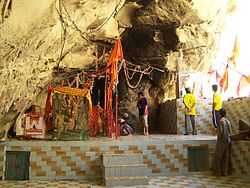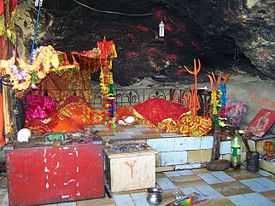Hinglaj
| Hinglaj | |
|---|---|
 Hinglaj | |
| Coordinates: 25.0°30′50″N 65.0°30′55″E / 25.51389°N 65.51528°ECoordinates: 25.0°30′50″N 65.0°30′55″E / 25.51389°N 65.51528°E | |
| Country |
|
| Province | Balochistan |
| Time zone | PST (UTC+5) |
Hinglaj (Sindhi: هنگلاج, Urdu: ﮨنگلاج, Sanskrit: हिङ्ग्लाज, Hindi: हिंगलाज) is an important Hindu pilgrimage place in Balochistan, Pakistan and Kuldevi of many Kshatriya and other Hindu Communities of India. It is situated in Balochistan province about 250 km north of Karachi.[1]
Theological origin

To still the divine dance, Tandava, of Lord Shiva following the death of Dakshayani, Lord Vishnu scattered the remains of her embodiment over various places of the Indian subcontinent. It is said that the head fell at Hingula or Hinglaj and is thus considered the most important of the 51 Shakti Peeths. At each of the Peeths, Bhairava (a manifestation of Shiva) accompanies the relics. The Bhairava at Hinglaj is called Bhimalochana, located in Koteshwar, Kutch. The Sanskrit texts mention the part as 'Brahmadreya' or vital essence. For details, see this.
The mantra or incantation for Devi Hinglaj is attributed to Saint Dadhichi, an important saint in Hindu theology. The mantra is :
ॐ हिंगुले परमहिंगुले अमृतरूपिणि तनुशक्ति
मनः शिवे श्री हिंगुलाय नमः स्वाहा
OM HINGULE PARAM HINGULE AMRUTRUPINI TANU SHAKTI
MANAH SHIVE SHREE HINGULAI NAMAH SWAHA
Translation : "Oh Hingula Devi, she who holds nectar in her self and is power incarnate. She who is one with Lord Shiva, to her we pay our respects and make this offering (swaha)."
Yet another incarnation:
ब्रह्मरंध्रम् हिंगुलायाम् भैरवो भीमलोचन: |
कोट्टरी सा महामाया त्रिगुणा या दिगम्बरी ||
BRAHMARANDHRAM HINGULAAYAAM BHAIRAVO VIMALOCHANAH
KOTTARI SAA MAHAAMAAYAA TRIGUNAA YAA DIGAMVARI
Translation : "Mahaamaayaa (Queen of Illusions) who represents the supreme virtue by reigning over all three virtues, has Bhimalochana as her Bhairava, and derides the worldly trappings by dancing naked, resides in this cave of Hingula that enshrines her sacred head."
Geographical location
Hinglaj is situated in the Balochistan province of Pakistan. It is near the peak of one of the mountains of the Makran Coastal Range. It is approximately 120 km from the Indus River Delta and 20 km from the Arabian Sea. The area is extremely arid and the pilgrimage also called 'Nani ki Haj' by local Muslims takes place before summer. The pilgrimage starts at a place near the Hao river which is 10 km from Karachi.


The name of Hinglaj lends itself to the Hingol river, the largest in Balochistan and the Hingol National Park which at 6,200 square kilometers is the largest in Pakistan.
Since it is located in a desert which is called Maru in Sanskrit, the shrine is referred to in holy texts as "Marutirtha Hinglaj" which means Hinglaj, the Shrine of the Desert. "Marutirtha Hinglaj" (Bengali: মরুতীর্থ হিংলাজ) is also the name of a Bengali novel by Kalikananda Abadhut (Bengali: কলিকানন্দ অবধূত) who made a pilgrimage to Hinglaj and Koteshwar, Kutch. The novel is based on real-life experience and has later been adapted into a very successful Indian Bengali movie of the same name (মরুতীর্থ হিংলাজ 1959, Director: Bikash Roy; casting: Anil Chatterjee, Uttam Kumar, Sabitri Chatterjee, Pahari Sanyal, Bikash Roy, Chandrabati Devi).
The Makran Coastal Highway linking Karachi with Gwadar runs parallel to Balochistan's Arabian Sea coast. It was built by Frontier Works Organisation and follows the same path which Alexander the Great took when he ended his campaign. The highway has made the pilgrimage and visiting the shrine very convenient.
Social significance
Despite the partition and the increasing Islamic stance of the Pakistani Government and society, Hinglaj has survived and is in fact revered by local Muslims who call it 'Nani ki Mandir'. Muslims offer red or saffron clothes, incense, candles and a sweet preparation called 'Sirini' to the deity[citation needed]. The Muslims protected sites like Hinglaj which are the last vestiges of the Hindu society which once straddled the area.
Hingula means cinnabar (HgS Mercuric Sulphide). It was used in ancient India to cure snakebite and other poisonings and is still employed in traditional medicine. The Goddess Hingula is thus believed to possess powers which can cure poisoning and other diseases. The Muslim name 'Nani' is an abbreviation of the name of the ancient Goddess "Nanaia", whose Persian name is "Anahita".
Pilgrimage
Although the road linking the port of Gwadar on the Arabian Sea with the interior has shortened the pilgrimage a lot, the ancient path followed for millennia through the Baluch desert is endowed with a unique importance. The very journey on foot is considered a penance to purify oneself before approaching the deity. An account of such a journey is given below.
The pilgrims are led by priests or caretakers of the shrine through the desert. They hold a wooden trident in their hands. The trident or Trishul is the weapon of Lord Shiva and hence is associated with the Sati too. Since they hold the trident during the trip, they are called 'Charidaars' (those who hold the stick or chadi). The Chadi is draped with saffron, red or pink coloured fabrics.
The priests give a saffron cloth to every pilgrim and an oath is taken that each would help the other. However they are warned not to share their personal stores of water. This act is deemed to be a sort of fast and penance necessary for the journey.
On the path to the shrine are situated wells which are guarded by the local tribesmen. Feuds over water, a scarce commodity, is common in the area. The tribesmen are offered food consisting primarily of Roti (circular flat disks of baked flour) in lieu of water.
Baba Chandrakup
An important stop during the pilgrimage is the mud volcano called 'Chandrakup' (Bengali: চন্দ্রকূপ, literally 'Moon Well'), mainland Asia's largest mud volcano. It is considered holy and is addressed as 'Baba Chandrakup'(literally Father Moonwell). The volcano is filled with mud, instead of magma, hence the term "mud volcano". It is considered to be the abode of demigod Babhaknath. It is one of the few sites of active volcanic activity in the Asian mainland. The mud is semi fluid and sometimes it spills over and aggregates and cools into hillocks which surround the site. There are altogether 18 mud volcanoes in the region. There is another such mud volcano in Andaman Islands, India.
Pilgrims stay up all night at the base of the volcano making Rotis which are offered to the volcano. The activity is considered to be very holy. The ingredients, flour, ghee (clarified butter), jaggery, sugar are mixed on a cloth which is held at all times at four corners by pilgrims. This is done to ensure that it never touches the ground. The prepared rotis are covered with wood.
At daybreak, the Rotis are carried by the pilgrims and priests to the mouth of the crater. A Chadi or Wooden Trident is planted near the edge of the crater and offerings of incense and cannabis are made along with recitation of 'mantras'. The rotis are then tore up and cast into the crater.
After this ritual every pilgrim is asked to confess his sins and ask for forgiveness. Anyone who refuses or hesitates to confess to his or her sins is ostracised and abandoned by the party. After the confession, the party proceeds with the permission of 'Baba Chandrakup'.
Reaching the shrine
The pilgrimage continues for another four to five days after leaving Chandrakup. The final stop is a small village with wooden houses. It is home to the caretakers of the shrine and Baluch tribesmen who revere the deity even though they are Muslims. Before entering the shrine, the pilgrims bathe in the Hingol River (also called the Aghore River). The shrine is situated on the mountain on the other bank of the river. The pilgrims bathe and visit the shrine in their wet clothes.
Shrine's mark
The shrine is recognised by a mark which resembles the sun and the moon. This mark is upon a giant boulder at the top of the hill containing the cave. It is believed that Lord Ram created this mark with the strike of his arrow after his penance ended.
Shrine
The shrine is called 'Mahal', a word of Arabic origin which means palace. The natural beauty of the shrine has spawned folklore that it was constructed by demigods called 'Yakshas'. The walls and roof of the cave are encrusted with colourful stones and semi-precious veins. The floor is also multi hued.

The entrance to the cave is around 50 feet in height. At the end of the cave is the sanctum sanctorum, which houses the holy relic. It is covered by red clothes and vermilion. There are two entrances to the sanctum. One has to crawl into the sanctum, take the 'darshan' and leave through the other opening. Prasad is distributed to the pilgrims and they return after seeing the Milky Way at night.
Hingula Pithas
Although the Hingula shrine in Balochistan is considered to be a true Shakti Peeth, other shrines dedicated to the goddess exist in India and Sri Lanka. One important shrine is located 14 km from Talcher in the state of Orissa in India. King Nala of the Vidarbha region of Western India was an ardent devotee of Devi Hingula. He was approached by the King of Puri for help. In order to start cooking 'Mahaprasada' for Lord Jagannath he had to procure Devi Hingula as fire for the temple kitchen. The Goddess agreed and moved to Puri as fire.
Kuldevi
She is worshiped as Kuldevi by many Kshatriya & other Hindu communities of India like Khatri Brahmakshatriya, Bhavsar, Bhanushali,Kapdi, Vanza, Bhadresa, etc.
See also
She is worshiped as Kuldevi by many Anavil Brahmin,Kshatriya & other Hindu communities of India like Khatri Brahmakshatriya, Bhavsar, Bhanushali,Kapdi,kapadiya,charan(deviputra) etc.
[2]== Notes ==
- ↑ Hindus in Pakistan - BBC News
- ↑ darshan yatra details for hinglaj mataji and mobile no or Id
References
- Overseas Pakistan Foundation
- Tarun Vijay (March 20, 2006). "Baluchistan Diary". Outlook India.
- Marutirtha Hinglaj
- Mr. Jay Shah's road trip to Hinglaj (Video on Vimeo)
- 4×4 Offroaders Club of Karachi - Visit to Hinglaj & mud-valcano
- Hingula worship in Orissa
| ||||||||